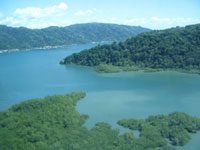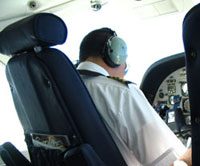February 11, 2005
Golfito. Friday, February 11th 2005
I’m in Golfito. On one side there is jungle; on the other, ocean, and the Ranger should arrive any day. The adventure begins.
The trip to the ocean has been mostly through the air. I took a plane from DC to Miami; from Miami to San Jose; and this morning, in a plane that would fit in my bedroom, from San Jose to here.

Costa Rica is mountainous. From above it looks like wrinkled silk, the peaks clay-colored, the valleys full of a deep green, the ridges veined with dirt roads. I descended into San Jose for a night, and this morning, with Xavier Pastor (director of Oceana Europe), took to the sky again. The plane was no more than an aluminum cocoon — I think it held 10 of us, tightly — and I felt as foolish as a deluded butterfly trying to fly cocoon-bound. We at least had wings and we rose, miraculously, up out of the peaks until we were looking down again on the wrinkled land.
It wasn’t more than twenty minutes before the ocean appeared at the horizon. It stretched forward to meet us, a smooth panel of electric blue. There was a long band of beach between the forest and the bright, bright sea. I think I will move here.

After an hour flying south along the coast and the margin of el Golfo Dulce — the “sweet gulf” — a smaller inlet opened landward — el golfito, the “little gulf.” There was the town: a string of buildings along the water, a marina with a single quay, a few masts. Our toy airplane dropped, dropped, coasted over palm trees — suddenly it seemed there were lush, wet-looking leaves on all sides — and touched ground on the landing strip that comprises the Golfito “airport.”
So here I am — safe and sound — typing away in the office of MarViva, a Central American organization that works to protect the marine life of Central America and to curb the illegal fishing (particularly shark finning) that is rampant here. We’ll be collaborating with MarViva in the next few weeks as we prepare to meet the Ranger, gather our supplies, and head out to Cocos Island — at base a volcanic rock formation that serves as a magnetic landmark on the migratory paths of big fish like tuna and marlin. And sharks. Cocos is said to have the highest concentration of sharks per square meter of water of any place in the world. In addition to looking out for illegal shark-finning boats, the Ranger crew has plans to take underwater footage of the schooling hammerheads and whatever else we find. More frightening than a doll-sized airplane? Maybe. But we’re taking things one step at a time.

